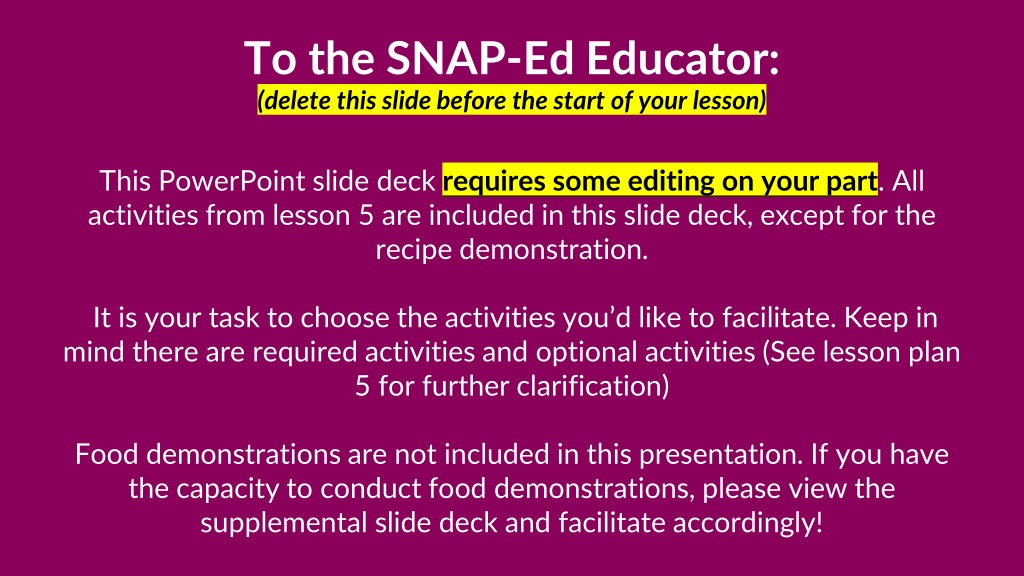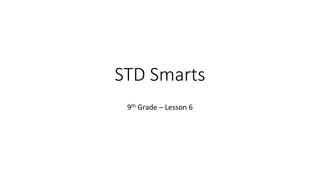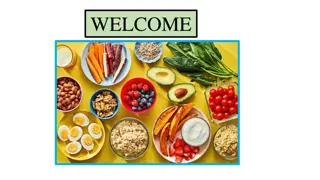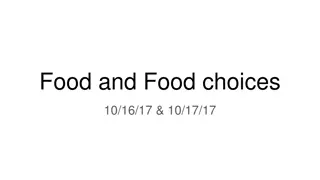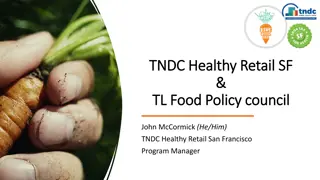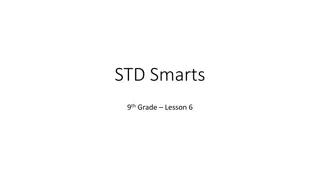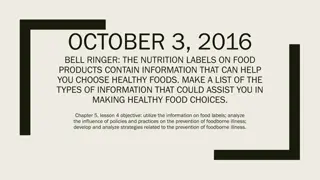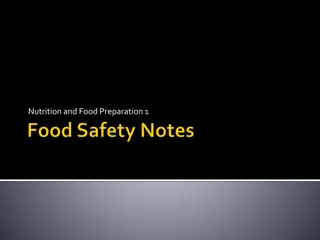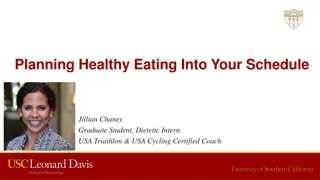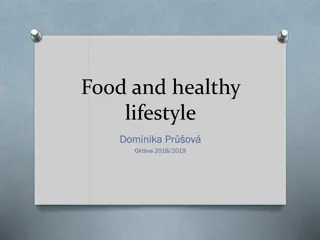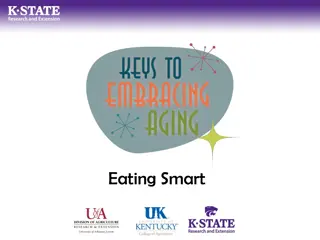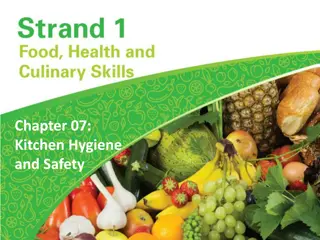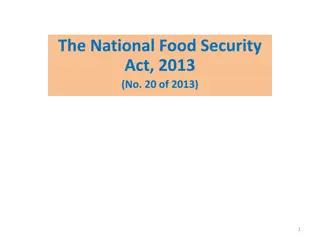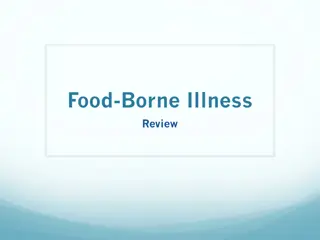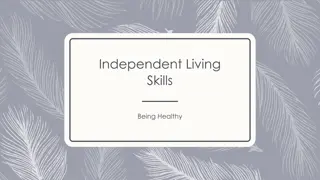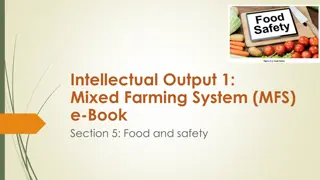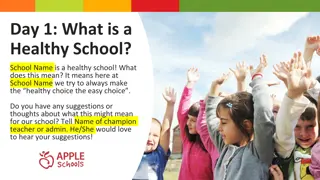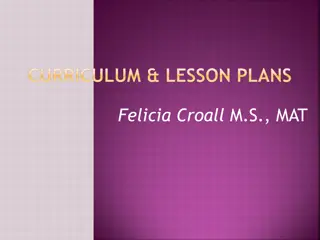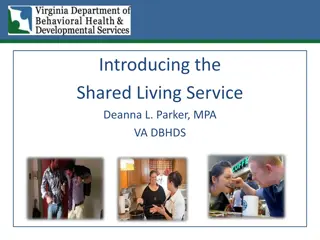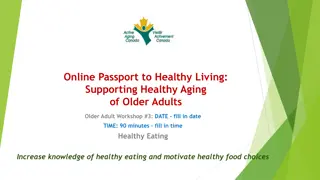Food Smarts Lesson 5: Healthy Living Practices
Explore best practices for healthy living in Food Smarts Lesson 5, focusing on activities like brain breaks, status checks, taste tests, and more to engage participants in discussions and interactive learning. Educators are encouraged to customize the presentation to suit their audience and facilitate engaging sessions promoting well-being.
Download Presentation

Please find below an Image/Link to download the presentation.
The content on the website is provided AS IS for your information and personal use only. It may not be sold, licensed, or shared on other websites without obtaining consent from the author. Download presentation by click this link. If you encounter any issues during the download, it is possible that the publisher has removed the file from their server.
E N D
Presentation Transcript
To the SNAP-Ed Educator: (delete this slide before the start of your lesson) This PowerPoint slide deck requires some editing on your part. All activities from lesson 5 are included in this slide deck, except for the recipe demonstration. It is your task to choose the activities you d like to facilitate. Keep in mind there are required activities and optional activities (See lesson plan 5 for further clarification) Food demonstrations are not included in this presentation. If you have the capacity to conduct food demonstrations, please view the supplemental slide deck and facilitate accordingly!
In accordance with Federal law and U.S. Department of Agricultures policy, this institution is prohibited from discriminating on the basis of race, color, national origin, sex, age, religion, political beliefs, or disability.
Food Smarts Lesson 5: Best Practices for Healthy Living
Please rename yourself what you would like to be called during class. Welcome + Tech Check Can you mute/unmute, show video and use the chat box? Please turn on video if possible. 4
Today s discussion: Best Practices for Healthy Living Materials needed: Pen, pencil, scratch paper Review Class Rules: Mute mic while others talk, raise hand to share Overview of Class 5
Brain Break Activity Wheel SPIN tekhnologic
RED I am feeling totally overloaded, stressed and on edge. Support or space is needed to make me feel better. ORANGE -I am juggling many things. It is hard to stay focused and learn new information. I need to make a change soon or my brain will explode. YELLOW There is lots going on, but I am still managing okay GREEN I am feeling positive and balanced. I have mental space to reflect, assess, be creative or try new things. BLUE I am feeling sad, depressed, grief, or loss of control GRAY I am lacking energy. I feel bored, unfulfilled, and/or numb Status Check: How are you doing?
Flavored Water Recipe 1. Fill a pitcher with cool water. 2. Add 1/2 cup thinly sliced cucumber and 1/2 cup fresh mint leaves. Chill in refrigerator. Enjoy! Try different combinations of flavors: Thin slices: lemon, lime, orange, grapefruit, cucumber, apple, berries, melon, pineapple, fresh ginger Fresh whole leaves or sprigs: mint, basil, rosemary, parsley Rethink Your Drink Kids Workbook p. 43
Jessie hates to get up in the morning! She would rather sleep in than eat breakfast. But by the time she gets to school, she feels hungry and tired. She often falls asleep in class. She eats mostly from the school cafeteria, but usually chooses foods like chips, juice and French fries. After school, she often snacks on soda, cookies and candy. Her mom always comes home and cooks a healthy dinner. Discussion Questions Discussion Questions 1. What Problem does Jessie have? 2. What will be the hardest change for Jessie to make? 3. What advice would you give Jessie? Healthy Changes Case #1 Youth workbook p. 57
Tony is an athlete who has practice almost every day after school. He needs to eat a lot and he does! He eats cereal in the morning, lunch in the cafeteria, and a fast food meal every day before practice. His mom makes big dinners like fried chicken and mashed potatoes. Although he s really active, Tony is worried he weighs too much. He s also concerned about having enough energy. Discussion Questions Discussion Questions 1. What Problem does Tony have? 2. What will be the hardest change for Tony to make? 3. What advice would you give Tony? Healthy Changes Case #2 Youth workbook p. 57
Jill doesnt eat regular meals. If shes up in time, she eats breakfast but often skips lunch because she doesn t like the food in the cafeteria. She drinks a lot of diet soda but eats mostly fruit, cheese, vegetables and bread. She has a hard time resting at night and often eats around 11 p.m. Her family doesn t eat dinner together every night. Discussion Questions Discussion Questions 1. What Problem does Jill have? 2. What will be the hardest change for Jill to make? 3. What advice would you give Jill? Healthy Changes Case #3 Youth workbook p. 57
Activity Charades
Reflection Reflection 1. What are some things that everyone can do every day to be active? 2. Why is being active an important part of a healthy life? 3. Why is being active every day challenging? What gets in the way?
How might you use these ideas to move for 60 minutes each day? How might you use these ideas to move for 60 minutes each day? Jump rope Jumping jacks Dance parties Wrestling Housework Stairs instead of the elevator Yoga or stretching Hula Hoop What else can you think of?
What is your favorite way to get exercise? Be Closing Question 22
Recipes to try this week: Fruit Spritzer or Green Smoothie Thank You and see you next week! 23
In accordance with Federal law and U.S. Department of Agricultures policy, this institution is prohibited from discriminating on the basis of race, color, national origin, sex, age, religion, political beliefs, or disability.
In accordance with Federal law and U.S. Department of Agriculture (USDA) civil rights regulations and policies, this institution is prohibited from discriminating on the basis of race, color, national origin, sex, religious creed, disability, age, political beliefs, or reprisal or retaliation for prior civil rights activity. To file a program discrimination complaint, a complainant should complete a Form AD-3027, USDA Program Discrimination Complaint Form, which can be obtained online at https://www.ascr.usda.gov/sites/default/files/ USDA-OASCR%20P-Complaint-Form-0508-0002- 508-11-28- 17Fax2Mail.pdf, from any USDA office, by calling (866) 632-9992, or by writing a letter addressed to USDA. The letter must contain the complainant s name, address, telephone number and a written description of the alleged discriminatory action in sufficient detail to inform the Assistant Secretary for Civil Rights (ASCR) about the nature and date of an alleged civil rights violation. The completed AD-3027 form or letter must be submitted to USDA by: Mail: U.S. Department of Agriculture Office of the Assistant Secretary for Civil Rights 1400 Independence Avenue, SW Washington, D.C. 20250-9410; or Fax: (833) 256-1665 or (202) 690-7442; Email: program.intake@usda.gov. This institution is an equal opportunity provider.
Conforme a la ley federal y las polticas y regulaciones de derechos civiles del Departamento de Agricultura de los Estados Unidos (USDA), esta instituci n tiene prohibido discriminar por motivos de raza, color, origen nacional, sexo, credo religioso, discapacidad, edad, creencias pol ticas, venganza o represalia por actividades realizadas en el pasado relacionadas con los derechos civiles. Para presentar una queja por discriminaci n en el programa, el reclamante debe completar un formulario AD-3027, Formulario de queja por discriminaci n del programa del USDA, que se puede obtener en l nea, en https://www.ascr.usda.gov/sites/default/files/ USDA-OASCR%20P- Complaint-Form-0508-0002-508-11-28- 17Fax2Mail.pdf, en cualquier oficina del USDA, llamando al (866) 632-9992, o escribiendo una carta dirigida al USDA. La carta debe contener el nombre, la direcci n y el n mero de tel fono del reclamante, y una descripci n escrita de la supuesta acci n discriminatoria con suficiente detalle para informar al Subsecretario de Derechos Civiles (ASCR, por sus siglas en ingl s) sobre la naturaleza y la fecha de la presunta violaci n de los derechos civiles. La carta o el formulario AD-3027 completado debe enviarse al USDA por medio de: Correo postal: U.S. Department of Agriculture Office of the Assistant Secretary for Civil Rights 1400 Independence Avenue, SW Washington, D.C. 20250-9410; o Fax: (833) 256-1665 o (202) 690-7442; Correo electr nico: program.intake@usda.gov. Esta instituci n ofrece igualdad de oportunidades.
